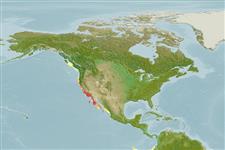Environment: milieu / climate zone / depth range / distribution range
Ecologia
marinhas demersal; intervalo de profundidade 4 - 450 m (Ref. 96339), usually 55 - 244 m (Ref. 96339). Subtropical
Eastern Pacific: southern Oregon, USA to central Baja California, Mexico.
Tamanho / Peso / Idade
Maturity: Lm ? range ? - ? cm
Max length : 25.0 cm TL macho/indeterminado; (Ref. 2850)
Mostly found on mud bottom from 55-244 m depth. Polychaete worms appear to be the preferred food, but euphausiids, amphipods, and fish eggs have been found in their stomachs (Ref. 4525).
Life cycle and mating behavior
Maturities | Reprodução | Spawnings | Egg(s) | Fecundities | Larvas
Eschmeyer, W.N., E.S. Herald and H. Hammann, 1983. A field guide to Pacific coast fishes of North America. Boston (MA, USA): Houghton Mifflin Company. xii+336 p. (Ref. 2850)
Categoria na Lista Vermelha da IUCN (Ref. 130435)
Ameaça para o homem
Harmless
Utilização humana
Ferramentas
Relatórios especiais
Descarregue XML
Fontes da internet
Estimates based on models
Preferred temperature (Ref.
123201): 8.1 - 16.7, mean 10.8 °C (based on 36 cells).
Phylogenetic diversity index (Ref.
82804): PD
50 = 0.7502 [Uniqueness, from 0.5 = low to 2.0 = high].
Bayesian length-weight: a=0.00380 (0.00147 - 0.00981), b=3.15 (2.92 - 3.38), in cm total length, based on LWR estimates for this (Sub)family-body shape (Ref.
93245).
Nível Trófico (Ref.
69278): 3.4 ±0.40 se; based on food items.
Generation time: 4.1 ( na - na) years. Estimated as median ln(3)/K based on 1
growth studies.
Resiliência (Ref.
120179): Médio, tempo mínimo de duplicação da população 1,4 - 4,4 anos (K=0.27).
Fishing Vulnerability (Ref.
59153): Moderate vulnerability (37 of 100).
